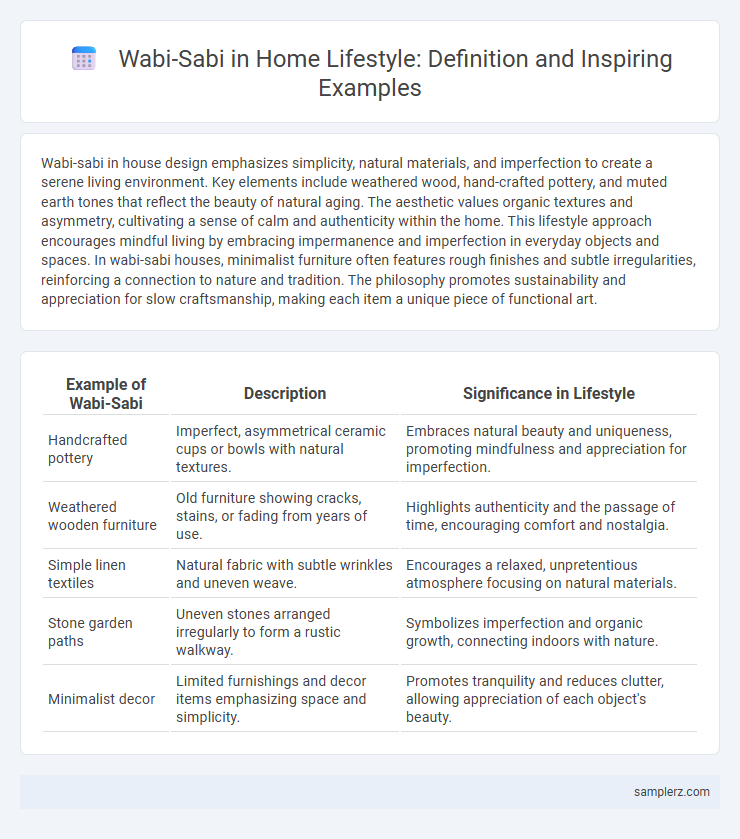Wabi-sabi in house design emphasizes simplicity, natural materials, and imperfection to create a serene living environment. Key elements include weathered wood, hand-crafted pottery, and muted earth tones that reflect the beauty of natural aging. The aesthetic values organic textures and asymmetry, cultivating a sense of calm and authenticity within the home. This lifestyle approach encourages mindful living by embracing impermanence and imperfection in everyday objects and spaces. In wabi-sabi houses, minimalist furniture often features rough finishes and subtle irregularities, reinforcing a connection to nature and tradition. The philosophy promotes sustainability and appreciation for slow craftsmanship, making each item a unique piece of functional art.
Table of Comparison
| Example of Wabi-Sabi | Description | Significance in Lifestyle |
|---|---|---|
| Handcrafted pottery | Imperfect, asymmetrical ceramic cups or bowls with natural textures. | Embraces natural beauty and uniqueness, promoting mindfulness and appreciation for imperfection. |
| Weathered wooden furniture | Old furniture showing cracks, stains, or fading from years of use. | Highlights authenticity and the passage of time, encouraging comfort and nostalgia. |
| Simple linen textiles | Natural fabric with subtle wrinkles and uneven weave. | Encourages a relaxed, unpretentious atmosphere focusing on natural materials. |
| Stone garden paths | Uneven stones arranged irregularly to form a rustic walkway. | Symbolizes imperfection and organic growth, connecting indoors with nature. |
| Minimalist decor | Limited furnishings and decor items emphasizing space and simplicity. | Promotes tranquility and reduces clutter, allowing appreciation of each object's beauty. |
Embracing Imperfection: Wabi-Sabi Aesthetics at Home
Wabi-sabi aesthetics at home emphasize natural materials like weathered wood, cracked pottery, and faded textiles, celebrating imperfection and transience. This Japanese philosophy encourages minimalist decor with asymmetrical designs and a muted color palette, creating a calming, organic ambiance. By embracing flaws and aging elements, wabi-sabi transforms living spaces into authentic environments that highlight beauty in simplicity and impermanence.
Natural Materials: The Heart of Wabi-Sabi Interiors
Wabi-sabi interiors embrace natural materials such as raw wood, stone, and linen, highlighting their organic textures and imperfection. These elements create a warm, authentic atmosphere that reflects the beauty of transience and simplicity. Incorporating weathered surfaces and handmade pottery emphasizes the connection to nature and the passage of time.
Celebrating Age: Patina and Vintage Décor
Embracing wabi-sabi in home design highlights the beauty of patina and vintage decor, where worn surfaces and aged materials tell a unique story of time's passage. Weathered wood, faded textiles, and antique furniture exude warmth and authenticity, creating a serene atmosphere that honors imperfection and natural aging. This celebration of age fosters a calming, grounded lifestyle that values understated elegance and the charm of history.
Minimalism with Warmth: Simplicity in Wabi-Sabi Design
Wabi-sabi design embraces minimalism with warmth by highlighting natural materials like wood and stone, creating a cozy and inviting atmosphere. Imperfections in handcrafted furniture and rustic textures add character, emphasizing authenticity and simplicity. This approach fosters a serene living space that balances functionality with understated elegance.
Rough Textures: Organic Surfaces and Finishes
Rough textures in wabi-sabi home design emphasize the beauty of organic surfaces and natural finishes, such as hand-hewn wood, uneven plaster walls, and stone countertops with imperfections. These elements highlight impermanence and authenticity by celebrating irregularities and raw materials over polished, mass-produced aesthetics. Incorporating tactile surfaces that age gracefully fosters a serene, grounded atmosphere reflecting the philosophy of embracing imperfection and transience.
Handmade Touches: Artisanal Elements in Each Room
Handmade touches in a wabi-sabi home emphasize artisanal elements, such as hand-thrown pottery in the kitchen and handwoven textiles in the living room. These imperfections and unique textures create a warm, authentic atmosphere that celebrates natural beauty and craftsmanship. Incorporating handcrafted wooden furniture with visible grain enhances the organic, imperfect aesthetics central to wabi-sabi philosophy.
Nature Indoors: Integrating Plants and Stones
Incorporating wabi-sabi principles into home design emphasizes natural imperfection through the use of organic elements like plants and stones. Indoor greenery such as potted ferns, succulents, and trailing vines brings a sense of tranquility and life, while raw stones and pebbles add texture and grounding earthiness. This harmonious blend creates a serene atmosphere that celebrates simplicity and the beauty of natural aging within living spaces.
Uncluttered Spaces: Mindful Arrangement and Negative Space
Wabi-sabi in home design emphasizes uncluttered spaces through mindful arrangement, valuing simplicity and intentional placement that highlights negative space. This approach creates a calming atmosphere by allowing objects to breathe and encouraging appreciation for imperfection and natural beauty. Integrating minimal furnishings and organic materials enhances tranquility and fosters a deep connection with the surrounding environment.
Subtle Colors: Earthy Hues and Soft Palettes
Wabi-sabi interiors embrace subtle colors through earthy hues and soft palettes, creating a calming atmosphere that highlights natural imperfections. Shades like muted taupe, warm beige, and gentle olive complement raw wooden textures and handcrafted ceramics to evoke simplicity and authenticity. This minimalist color scheme enhances the organic beauty and tranquil balance central to wabi-sabi lifestyle aesthetics.
Everyday Beauty: Finding Wabi-Sabi in Daily Objects
Embracing wabi-sabi in everyday objects reveals the beauty of imperfection and natural aging, such as a chipped ceramic mug or a worn wooden table. These items embody simplicity and authenticity, highlighting the charm found in patina, asymmetry, and modesty. Incorporating such elements into home decor fosters a tranquil atmosphere that celebrates the transient and imperfect nature of life.

example of wabi-sabi in house Infographic
 samplerz.com
samplerz.com